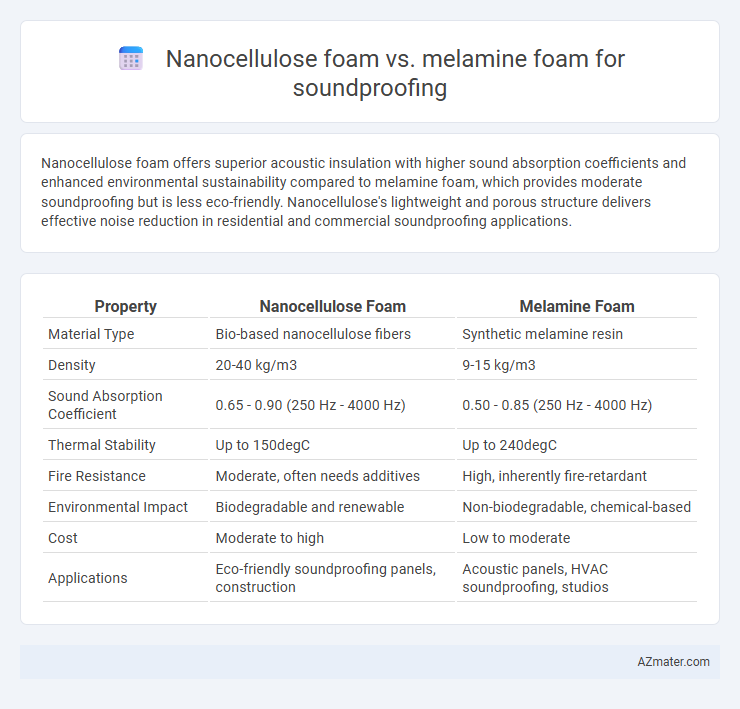Nanocellulose foam offers superior acoustic insulation with higher sound absorption coefficients and enhanced environmental sustainability compared to melamine foam, which provides moderate soundproofing but is less eco-friendly. Nanocellulose's lightweight and porous structure delivers effective noise reduction in residential and commercial soundproofing applications.
Table of Comparison
| Property | Nanocellulose Foam | Melamine Foam |
|---|---|---|
| Material Type | Bio-based nanocellulose fibers | Synthetic melamine resin |
| Density | 20-40 kg/m3 | 9-15 kg/m3 |
| Sound Absorption Coefficient | 0.65 - 0.90 (250 Hz - 4000 Hz) | 0.50 - 0.85 (250 Hz - 4000 Hz) |
| Thermal Stability | Up to 150degC | Up to 240degC |
| Fire Resistance | Moderate, often needs additives | High, inherently fire-retardant |
| Environmental Impact | Biodegradable and renewable | Non-biodegradable, chemical-based |
| Cost | Moderate to high | Low to moderate |
| Applications | Eco-friendly soundproofing panels, construction | Acoustic panels, HVAC soundproofing, studios |
Introduction to Acoustic Foam Materials
Nanocellulose foam and melamine foam serve as advanced acoustic foam materials, each offering distinct sound absorption properties. Nanocellulose foam, derived from renewable cellulose fibers, exhibits high porosity and low density, enhancing its capacity to dampen mid to high-frequency sound waves efficiently. Melamine foam, a synthetic polymer-based material, is renowned for its open-cell structure and thermal stability, providing excellent soundproofing performance across a broader frequency range, especially in industrial and commercial acoustic applications.
What is Nanocellulose Foam?
Nanocellulose foam is an advanced, lightweight acoustic material derived from cellulose fibers extracted from wood or plants, offering superior sound absorption and environmental sustainability. Its porous structure enables effective damping of a wide range of frequencies, making it ideal for soundproofing applications in construction and automotive industries. Compared to melamine foam, nanocellulose foam provides enhanced biodegradability and mechanical strength, promoting eco-friendly noise control solutions.
What is Melamine Foam?
Melamine foam is a lightweight, open-cell foam known for its excellent sound absorption and thermal insulation properties, commonly used in acoustic panels and soundproofing applications. Its porous structure effectively reduces noise by trapping sound waves, making it ideal for studios, offices, and industrial settings. Compared to nanocellulose foam, melamine foam offers superior fire resistance and durability but may be less sustainable due to its synthetic composition.
Soundproofing Mechanisms of Nanocellulose vs Melamine Foams
Nanocellulose foam exhibits superior soundproofing mechanisms through its highly porous, interconnected nanofiber network that effectively traps and dissipates sound waves by multiple scattering and viscous absorption. In contrast, melamine foam relies primarily on its open-cell structure to attenuate sound by converting acoustic energy into heat within its porous matrix. The nanostructured architecture of nanocellulose enhances low-frequency sound absorption and provides greater mechanical stiffness, making it more efficient for broad-spectrum noise reduction compared to the relatively uniform pore size and lower density of melamine foam.
Acoustic Performance Comparison
Nanocellulose foam exhibits superior sound absorption properties due to its highly porous nanostructure, enabling effective attenuation of a wide frequency range, particularly in mid to high frequencies. Melamine foam, widely used in acoustic panels, offers excellent noise reduction but tends to underperform in low-frequency soundproofing compared to nanocellulose materials. The nanocellulose foam's enhanced acoustic impedance and sustainable biomass origin make it an advanced alternative for efficient and eco-friendly soundproofing solutions.
Environmental Impact and Sustainability
Nanocellulose foam offers significant environmental benefits over melamine foam due to its biodegradability and derivation from renewable cellulose sources, reducing reliance on petrochemicals. Melamine foam, while effective for soundproofing, poses environmental concerns as it is non-biodegradable and requires energy-intensive manufacturing processes. Choosing nanocellulose foam enhances sustainability in soundproofing applications by minimizing ecological footprints and promoting circular material use.
Fire Resistance and Safety Features
Nanocellulose foam exhibits superior fire resistance compared to melamine foam due to its natural cellulose structure, which can be chemically treated to enhance flame retardancy without releasing toxic fumes. Melamine foam, while effective as a sound absorber, tends to melt and emit hazardous gases when exposed to high temperatures, posing greater safety risks in fire scenarios. Choosing nanocellulose foam for soundproofing applications ensures enhanced fire safety and environmental friendliness alongside acoustic performance.
Durability and Lifespan
Nanocellulose foam exhibits superior durability compared to melamine foam due to its high mechanical strength and resistance to environmental degradation, ensuring a longer lifespan in soundproofing applications. Melamine foam, while effective in acoustic absorption, tends to degrade faster under continuous exposure to moisture and physical stress, reducing its overall durability. The extended lifespan of nanocellulose foam makes it a more sustainable and cost-effective choice for long-term soundproofing solutions.
Cost Analysis and Commercial Availability
Nanocellulose foam offers a higher manufacturing cost due to its advanced biopolymer extraction process, whereas melamine foam benefits from large-scale production and lower raw material expenses, making it more affordable for commercial soundproofing applications. Commercial availability of melamine foam is widespread, supported by numerous suppliers and well-established supply chains, while nanocellulose foam remains limited to niche markets and specialized vendors primarily focused on sustainable or high-performance acoustic solutions. Cost-efficient melamine foam is preferred in mainstream construction and industrial soundproofing, whereas nanocellulose foam targets premium, eco-conscious projects despite higher pricing and restricted availability.
Best Applications for Nanocellulose and Melamine Foams
Nanocellulose foam excels in eco-friendly soundproofing applications, offering high porosity and biodegradability ideal for sustainable architectural acoustics and automotive interiors. Melamine foam provides superior thermal insulation and fire resistance, making it optimal for industrial noise control in factories and HVAC systems. Nanocellulose suits environments prioritizing environmental impact and lightweight materials, while melamine foam is preferred where flame retardancy and durability are critical.

Infographic: Nanocellulose foam vs Melamine foam for Soundproofing
 azmater.com
azmater.com